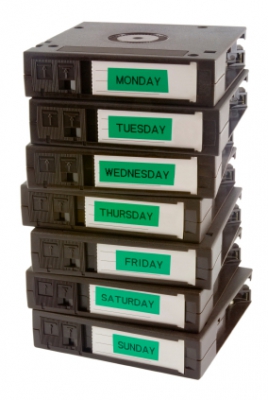Below you will find a list of main principles of successful data backup. Adhere to these principles when you design backup environments and you will get the most out of backup, and backed up information might help you a great deal in the future:
1. Mirroring does not substitute backups. This simple fact contradicts to the wide spread myth. Mirroring protects in case of damage or failure of equipment for data storage but it can’t help in case of accidentally deleted or damaged file. If file was deleted on one the mirror’s sides, it equally disappears from the other side and therefore should be recovered with the help of external tools. Prevailing but not the only external data recovery tools are tape backups.
2. Data recovery process is primarily used not after a disaster took place. Yes, of course, disasters happen, but possibility of a situation in which user accidentally deletes or damages one file or maybe a directory seems much more real than simultaneous damage or deletion of information from both sides of the mirror or from disks in RAID stripe, and a disaster taking place. That is why you should adjust your backup systems to time-optimized recovery of one file or directory.
3. Regularly test your systems for data recovery capability. Backup is of course important but if you are unable to recover data from backup tapes then you simply wasted your time and effort to create useless tapes. You don’t necessarily have to test each tape you created, but you have to regularly test each tape storage device to make sure that backup copies are readable, and from time to time you also need to perform random inspection of recorded tapes to make sure that it is possible to read and recover necessary information form it.
4. Tape drive heads should be clean. Dirty heads of tape drives could lead to seemingly successful backing up but in reality your recording represents a complete rubbish. Clean tape drive heads as often as it is recommended by the manufacturer or maybe even more often. If backup device gives you a tape read/write error message, immediately clean the heads. If error messages continue to appear, check whether other tapes have similar mistakes and contact your provider.
5. Beware of dirty tapes. No, we are not talking here about adult videos, we are talking about tapes. Sometimes a single spot – fold, stain or dirt can make the entire tape unreadable. Keep tapes in special cases in clean premises and test them from time to time.
6. Monitor tape MTBF (Mean Time Between Failures). If the manufacturer specifies that useful life of a tape is 1000 copies, use it 1000 and then dispose of it. Data recovery process is not the best time to find out that the tape is damaged. Good software that controls backup copy process will keep record of tape usage and will warn you when you need to replace it with a new one.
7. Tape deteriorates with time. Do not think that a tape that was made 5 or 6 years back is still readable today. Tapes do deteriorate: they are affected by weak magnetic field that affects the quality and some tapes simply cannot be kept in storage for a long period of time. When manufacturers release a new tape format on the market, it is very difficult for them to determine the real storage time. If they had to check it empirically, releasing new tapes on the market would have taken several years. Check your tapes regularly and copy them to new media from time to time. Pay attention to tape storage requirements to extend storage time and avoid too high or too low temperatures or moisture.
8. Make two copies of tapes with critical data. It is much cheaper to buy and maintain tapes than trying to recover critical data on them. To guarantee durability and security of your tapes and data make two copies of critical data and keep second come away from the office.
9. Make sure that you still can read old storage media. It is great to have a collection of old recordings but if you don’t have a player to play them, such collection is useless. The same is applicable to old magnetic tapes: if you cannot read old tapes, there is no use keeping them. When a new technology is introduced, copy old tapes to new media.

 In many ways data backup is one of the most important elements in critical systems’ design. If maintained properly, they represent the last protection line in case of any disaster. Even if an entire house or city has been erased from the face of the earth, your business can be recovered in another place and on other computers, using created according to all rules and extremely secure tapes containing backup information. But there are several conditions which you need to fulfil to make data recovery process successful.
In many ways data backup is one of the most important elements in critical systems’ design. If maintained properly, they represent the last protection line in case of any disaster. Even if an entire house or city has been erased from the face of the earth, your business can be recovered in another place and on other computers, using created according to all rules and extremely secure tapes containing backup information. But there are several conditions which you need to fulfil to make data recovery process successful.